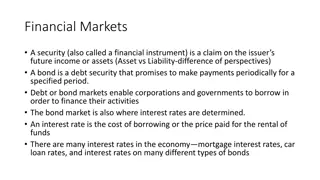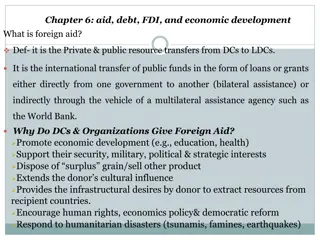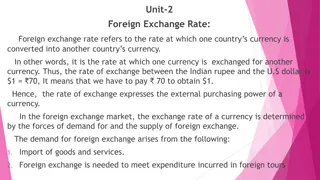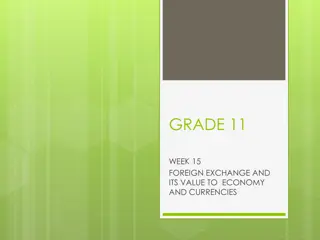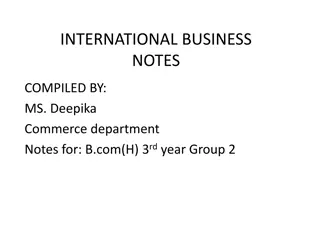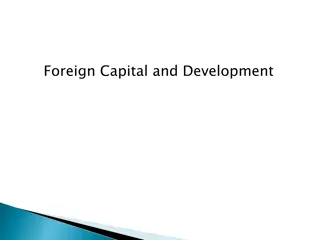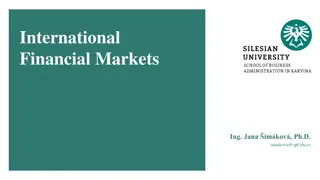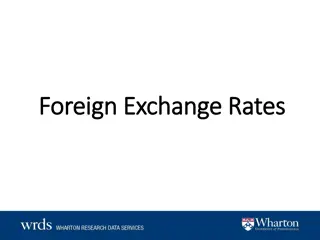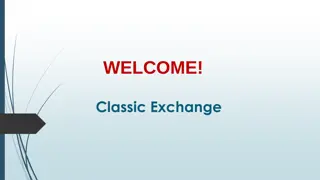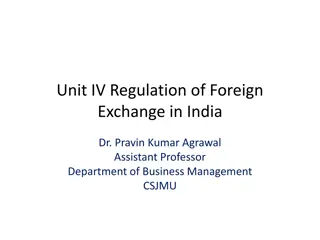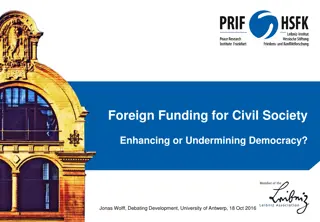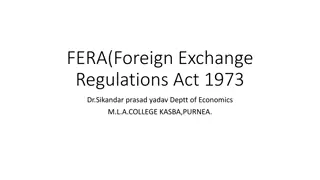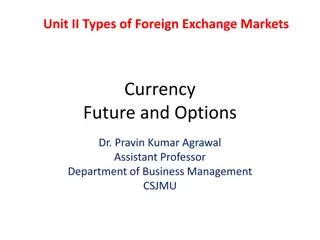Understanding Foreign Exchange Markets and Risks
Foreign exchange markets play a vital role in facilitating international trade and financial transactions due to the presence of multiple currencies. This article covers the participants in the FX market, various types of transactions, factors influencing exchange rates, and the different types of foreign exchange risks faced by individuals and entities involved in currency trading. Effective risk management strategies are essential for mitigating potential losses arising from exchange rate fluctuations.
Download Presentation

Please find below an Image/Link to download the presentation.
The content on the website is provided AS IS for your information and personal use only. It may not be sold, licensed, or shared on other websites without obtaining consent from the author. Download presentation by click this link. If you encounter any issues during the download, it is possible that the publisher has removed the file from their server.
E N D
Presentation Transcript
Currency Markets September 03, 2018 Babar Ali, CFA Senior Joint Director, Domestic markets & Monetary Management Department State Bank of Pakistan
Why Foreign Exchange Unlike barter system, currencies ensure smooth transactions Multiplicity of currencies involved in international trade and finance Not practical and feasible for a country to produce all the goods and services it needs Financial interaction between the countries is inevitable
FX Market Participants Commercial Banks Exchange Companies FX Market Brokers Central Banks Corporate Treasuries Import/Export Financing Investment/ Profit Remittance Other Financial Institutions Public Sector/Government Individuals
Types of Transactions Outright Transactions - Ready: - Tom: - Spot: - Forward: Settlement date more than two day ahead Settlement: Same Day Settlement: T+1 Settlement: T+2 FX Swap Transaction An FX Swap is a deal involving two transactions. The first transaction is to exchange currencies in one value date at an agreed rate. The second transaction is to reverse the first transaction for an other vale date at an agreed rate
Factors influencing FX Market Balance of payments - Import/Export - Foreign Investment - Foreign Debt Political Developments Economic Indicators - Economic Growth - Inflation - Interest Rates Government policies Central Bank intervention Market sentiment
Foreign Exchange Risk Exposure to exchange rate movement Any sale or purchase of foreign currency entails foreign exchange risk Carrying net assets or net liability position in any currency gives rise to exchange risk Transaction Exposure: Exposure due to an expected transaction Translation Exposure: Exposure due change in value of assets/liabilities Economic Exposure: Exposure of competitive position to exchange rate movement
Foreign Exchange Risk Risk management is a process of identifying, measuring and controlling risk Foreign Exchange Risk is not additive Foreign Exchange Risk reduces in the longer run Risk is diversified while investing in multiple currencies Risk can be hedged through Various derivatives: - Forwards/Futures - Options - Swaps
Exchange Rate Quotes Exchange rate is price of one currency against another expressed as a ratio Rate is always quoted between two currencies (A currency pair) One currency is called base currency and the other is called quoted currency An exchange rate is the price of one unit of base currency in terms of quoted currency
Base and Quoted Currency In an FX quote first currency is called base currency and the second currency is called quoted currency USD/PKR Base Currency Quoted Currency Example: USD/PKR = 123.50 123.50 is the price of one unit of USD (Base Currency) in terms of PKR (Quoted Currency)
Direct and Indirect Quotation Direct Quotation Quotes using a country's home currency as the quoted currency. USD/PKR = 123.50 Mostly currencies are quoted in as a Direct quotation. Indirect Quotation Quotes using a country's home currency as the base currency: EUR/USD = 1.1600 Currencies with Indirect quotation: EUR, GBP, AUD, and NZD.
Bid/Offer Rate An exchange rate quote consists of two parts: Bid/ Buying Rate Offer/ Selling Rate Party asking for quote is called Markettaker while party giving the rate or quote is called Marketmaker USD/PKR 123.50/55 123.50 is the buying rate at which market maker wants to buy USD i.e. base currency 123.50 is the selling rate at which market maker wants to sell USD i.e. the base currency
Cross Rates FX rates typically involve currencies quoted against the US dollar Cross rate is the rate between two currencies where neither of the two currencies is the US dollar For example: EUR/PKR EUR/GBP EUR/CHF GBP/JPY CHF/JPY 31
Forward Market The forward FX Market is where parties buy and sell currencies for delivery at some future date. For example a forward transaction dealt today could have value date of 1 month later One month, Two months, Three months, six months and one year forward dates are called Fixed Periods. Any value date falling between the fixed dates is called Broken Date or Odd Date. Periods above are known collectively as run. If a dealer asks for a run through, you would quote prices for all these fixed periods.
Forward Premium/Discount The difference between the forward and spot price is called Forward Premium/Discount Currency with higher forward rate than its spot rate is said to be traded at premium in forward Currency with lower forward rate than its spot rate is said to be traded at discount in forward
Forward Points Forward rates are quoted in forward points. For most currencies one point equals 0.0001 because currencies are quoted to four decimal places Forward rate is calculated by adding or deducting the forward points to or from the spot rate USD/PKR forward points are quoted in paisas USD/PKR Forward Points 20 / 22 60 / 62 100 / 105 220 / 230 450 / 455 Tenure 1 Month 2 Months 3 Months 6 Months 1 Year
Forwards and Interest Rate The difference between the forward and spot rates for two currencies is based on the difference between the interest rate of two currencies The currency with higher interest rate is traded at discount in forward The currency with lower interest rate is traded at premium in forward For example, an importer needs USD 100 Million after six months. It has two options: Buy USD 100 Million spot and invest for six months Buy USD 100 Million for delivery six months forward The two options above should produce same result otherwise there would be arbitrage opportunities
Domestic FX Market The FX market of the country can be seen as segmented into banks, and Exchange companies market Interbank market is the mainstream market and interbank rate is the benchmark rate Banks foreign exchange activity can be bifurcated into Interbank and retail (customers) transactions Banks can cover their transactions with customers back-to-back in interbank market or can keep the exposure on their own books
Bank Branch Operations Bank s two important units as far as its FX operations are concerned are Branches and Treasury Banks cater to the foreign exchange requirements of its customers though network of branches Banks foreign exchange activities are primarily generated through import, export, remittances, investments, profit repatriation/ dividends etc Margin between buying and selling rate for customers should not exceed 20 paisa Branches buying/selling of FX is off-loaded/covered from their treasury
Treasurys FX Operations A bank s treasury trades in interbank market to manage its position Banks have to manage their: Foreign Exchange Exposure/ Net Open Position (NOP) Nostro Accounts Foreign Exchange Exposure/ NOP refers to net asset or liability position in foreign currencies Nostro accounts: An entity s accounts in foreign currencies in countries of respective currencies FEEL is 20% of paid-up capital with maximum of PKR 3,500 million
Exchange Companies Minimum paid-up capital: Rs. 200 million Statutory Liquidity Reserve (SLR) : 25 percent of the Capital, in the form of unencumbered approved government securities Buying/Selling Buy and sell foreign exchange from/to individuals in Ready value only Buy and sell foreign exchange in Ready, Tom and Spot value dates from/to other Exchange Companies Sell foreign exchange to companies for remittance on account of royalty, Franchise, technical fee, repair and maintenance etc Sell foreign exchange in Ready, Tom and Spot value dates to banks
Exchange Companies Inward/Outward Remittances Exchange Companies shall take prior approval of State Bank before commencing inward home remittances operations All inward home remittance transactions shall be routed through foreign currency accounts of the Exchange Companies maintained with banks in Pakistan Minimum 15% of inward home remittances, must be sold in the interbank market on an ongoing basis Outward remittances are allowed only on personal account of individuals i.e. personal financial transactions and not those related to an individual's trade or business requirements
Exchange Companies Inward/Outward Remittances Corporate clients may effect outward remittances through an Exchange Company only on account of payment of royalty, technical/Franchise fee Exchange Companies are not allowed to effect outward remittances on account of trade related activities/payments against services/commission etc., whether on account of individual or on behalf of corporate clients
Exchange Companies B Category Minimum paid-up capital: Rs. 25 million. Statutory Liquidity Reserve (SLR) : 10 percent of the Capital, in the form of cash or unencumbered approved government securities Authorized to buy and sale foreign currency notes and coins from/to individuals, Exchange Companies and Exchange Companies of B category in Ready value only Allowed to sell foreign exchange in Ready value only to the banks as counter party Exchange Companies of B Category are prohibited from engaging in any other activity such as remittances, transfers, deposit taking, lending etc., directly or indirectly
Exchange Rate Data published by SBP Weighted Average Customer Exchange Rate http://www.sbp.org.pk/ecodata/rates/war/WAR-Current.asp These rates are compiled from the Exchange Rate sheets issued daily by various Commercial Banks providing their indicative Exchange Rates for commercial transaction with customers Exchange Rate for Mark-to-market revaluation http://www.sbp.org.pk/ecodata/rates/m2m/M2M-Current.asp These Exchange Rates are issued for Authorized Dealers to revalue their books daily on Mark-to-Market basis. These are compiled on the basis of closing Exchange rates prevailing in Inter Bank Foreign Exchange Market. Other External Sector Data http://www.sbp.org.pk/ecodata/index2.asp
Training & Development Needs Thank You




